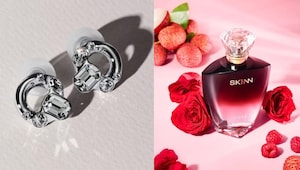Everything You Need to Know About Vulva Piercings
From inner labia to 'that bit near your perineum'.

Look, although loads of people think of anything in the pubic region as a 'vagina piercing', we're not talking about getting your actual vaginal canal pierced. That would just be madness. Technically, it would be correct to say vulva piercings, I guess. Basically, what we're on about is any genital piercing that isn't the clitoris and clitoral hood.
From labia, to Christina (or venus) and fourchette (we'll explain later), here's everything you need to know about vagina piercings.
Sexual benefits of 'vagina' piercings
While the piercings detailed below have little direct effect on sexual pleasure, many women and people with vulvas say having them done makes them feel sexy and therefore, more confident when having sex. Obstetrician and gynaecologist Dr Anne Henderson, from Doctify, says, "Everyone can benefit equally from their partner’s piercings given the aesthetic benefits of intimate jewellery, and the psychological benefits which this creates and which are key to an enjoyable sex life.
"It's true to say that a partner without piercings may therefore get as much visual pleasure from the impact of a partner’s vulva piercing as they do, which will have a doubly positive impact on their sex life!" Plus, they look super cute.
Experienced piercer Clem, who works in Topshop Oxford Street's in-house shop Metal Morphosis says these are the things you need to consider.
The actual piercings
Style
Inner and outer labia: Two types of piercings can be undertaken involving either the labia majora (larger outer labia) or labia minora (thinner and smaller inner labia).
Christina (or venus): This is a surface piercing carried out vertically, on the pubic or venus mound, which is the prominent fatty pad on the pubic bone just above the clitoris where the outer labia meet.
Fourchette - One of the least common genital piercings as many women and people with vulvas aren't suitable for it (they don't have a pinchable flap of skin to pierce), it's done at the rear rim of the vulva, close to the perineum. Once the jewellery is in, it looks like it sits just under the opening to the vagina.
Price: These piercings can cost anywhere from £80 to £100. Obviously it'll be pricier if you go for fancy jewellery like gold or platinum.
Suitability: Not everyone is suitable for the piercing, so depending on your anatomy a piercer may refuse to carry out the piercing.
Jewellery: Rings, bars (both straight and curves) in titanium, gold, white gold, rose gold, platinum or palladium. You can always change the jewellery once the piercing is totally healed.
Risk: With any piercings, there's always a tiny risk of it becoming infected. Make sure you follow the aftercare instruction provided by your piercer and this will be highly unlikely.
Procedure: Usually, genital piercings are done by appointment only as you'll need a consultation to ensure your anatomy allows for the piercing. Your piercer will also want to find out what you expect from the piercing so they can advise you on the correct jewellery.
Aftercare: A soap product isn't necessary for most - you don't want to kill the healthy bacteria that live in the genital region. A simple sea salt or saline solution wash twice a day (and after sex or masturbation) is sufficient unless you start having a problem. If you feel you need to cleanse the area more thoroughly, use a mild liquid anti-microbial soap (ask your piercer about availability of these products) and clean the piercing by applying a tiny drop of soap to piercing and jewellery. Then thoroughly rinse by applying clean water.
DO NOT allow your piercing to come in contact with any bodily fluids for the first few weeks while it heals. This includes semen, as well as saliva.You're not restricted from sexual activity, but a condom must be used for all sexual contact for at least two weeks. This includes masturbation and the use of sex toys.
Healing: Around eight weeks, but longer depending on the specific piercing. Christina, or venus, piercings can take up to four months. And labia piercings may need three months.
Pain: Look dude, you're getting a hole poked through your vulva, it's not exactly going to be a walk in the park. However, piercers promise the procedure is quick. And pain's all relative anyway, if you've got a high pain threshold you'll be groovy.
Health concerns
Dr Anne Henderson says there are a few health concerns to consider before getting a vulva piercing:
"There are a variety of problems which can arise, but these are minimised by ensuring that the practitioner is fully qualified, trained and insured. Infection is obviously one of the most common risks, and it's important that women take great care of the piercing site until it has fully healed.
"People may also find wearing sanitary protection more uncomfortable than normal and may have to use smaller sanitary pads, ideally organic/bleach free cotton if possible, and avoid the use of tampons for the first few weeks to minimise the risk of infection."
more from Life

Scents that make staying in feel like a winter wonderland

'Bridgerton' season 4 trailer: Benedict and Sophie are ready to serve a Cinderella-esque romance

How training for a marathon became the most honest conversation I have ever had with myself

Emily in Paris season 5 is back—and we’re still hate-watching every minute of it

The best makeup tonics to upgrade your skincare and makeup routine

Taylor Swift's exact workout that kept her stage ready for the Eras Tour

“Pebbling” is the non-toxic, genuinely adorable dating trend we all needed

Is 'future faking' the new gaslighting? Decoding this new dating trend

Bad at gifting? Check out these stocking stuffer ideas based on each zodiac sign

15 new Christmas movies you might want to add to your 2025 holiday watch list
